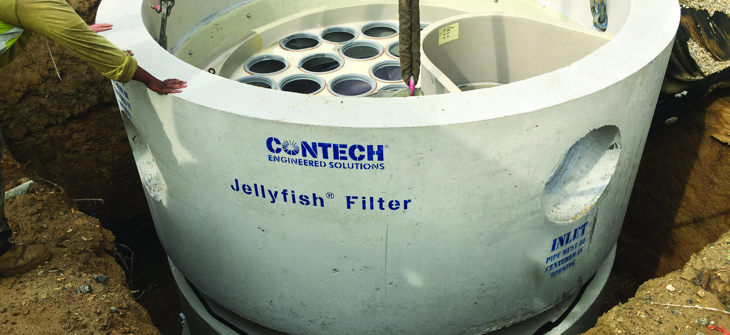
The MTD Stigma: Is It Finally Time To Move Manufactured Treatment Devices Out Of The Shadows?
It's Time to Rethink Manufactured Treatment Devices in Stormwater Design
Perhaps stigma is too strong a word, but for those that have been around storm water management circles a while, it’s hard to ignore the fact that manufactured storm water treatment devices (MTDs) continue to live in the shadows despite more than two decades of innovation, performance data and contributions to the storm water management sector at large. Regardless of how much credible data is available or how well a particular MTD performs relative to applicable standards, there is often still a level of skepticism and/or additional barriers in place relative to their use. It’s vital that we have a reasonable level of confidence in the performance expectations of all BMPs, but we shouldn’t unjustly overlook an entire drawer in our storm water toolbox. MTD providers continue to innovate and refine solutions that play a pivotal role in meeting storm water management requirements in highly urbanized areas, but if we don’t establish clear pathways for regulatory acceptance we will squander vital resources in the ever constrained fight to meet clean water goals.
My first exposure to MTDs and the broader world of storm water management came nearly 20 years ago (gasp!) as a newly minted environmental science graduate hoping to put my passion for the natural world to good use. I started my career working in research and development and was tasked with testing the performance of hydrodynamic separators in both the field and the laboratory as well as contributing to the development of new technologies, such as media filters. At the time, my thoughts were essentially, “sweet, a job working with and creating systems to clean water. What could be better?” Certainly a simple, albeit somewhat naïve, take on the storm water world at large.
At the time, hydrodynamic separators were just emerging. There were very few established standards or protocols to assess their performance and even fewer regulatory programs equipped to review the resulting data. Performance claims varied widely, proprietary sizing models limited comparability, and the competitive nature of the industry led to systems being installed that were not well suited to the job they were being implemented for. In other words, there were few rules in place even for those willing to follow them, and MTD providers certainly earned some of the skepticism bestowed upon them during that time.
In the years since, dozens of new technologies have been developed, including a variety of advanced and highly effective media filtration and engineered biofiltration systems. Additionally, test protocols and best practices have been refined repeatedly, regulations have grown increasingly stringent, and millions of dollars have been spent monitoring the performance of MTDs for various pollutants of concern. MTD performance verification programs, such as the New Jersey Department of Environmental Protection’s (NJDEP) MTD certification program1 and the Washington State Department of Ecology’s (Ecology) Technology Assessment Protocol- Ecology (TAPE) program2 are highly regarded throughout the industry, and the resulting MTD evaluations and approvals are reciprocated by regulatory programs throughout North America. It should come as no surprise that these programs are also being utilized to establish the foundation for the national verification process known as Stormwater Testing and Evaluation for Products and Practices3 (STEPP) that is currently being developed by a diverse group of stakeholders and ultimately, will be applicable for evaluating all types of BMPs.
MTDs first emerged to meet the need for viable storm water treatment solutions in highly urbanized areas with unique constraints that can make traditional land based BMPs impractical. As our storm water management strategies have evolved to focus on runoff reduction through onsite retention and the use of green infrastructure, many of those same site specific constraints remain. When runoff reduction goals are not fully achievable onsite, it should be a no brainer that effective flow through treatment options should be our next line of defense to avoid polluting receiving waters. Many different MTDs can be deployed in this scenario, but when regulations are overly prescriptive and only allow for a small subset of the BMP toolbox, or the local agency doesn’t have sufficient resources to vet MTDs and other innovative practices, overcoming such challenges can be problematic. In the worst case scenario, projects slated for an already urbanized area may instead move to a green field resulting in an even more impervious area and a net increase in storm water runoff.
Our collective knowledge of MTD performance has grown by leaps and bounds since the early days of aggressively sized hydrodynamic separators. Additionally, the diversity and effectiveness of MTD solutions has expanded considerably over the last two decades. The vast majority of MTD providers also recognize that the proof is in the pudding and willingly subject their technologies to robust monitoring, such as the NJDEP or TAPE programs, in order to demonstrate performance. Those that do not have credible data should continue to be viewed with a cautious eye, but regulatory programs should plot a path for new innovations to gain acceptance. Closing the door on all things new removes the incentive for investment in innovation, and we potentially lose out on the next generation of storm water solutions. In short, the storm water fight is far from over, and we need all the tools we can get if we ever expect to see fishable and swimmable become the norm.
References:
1. New Jersey Department of Environmental Protection MTD Certification Program. https://www.njstormwater.org/treatment.html. Accessed online: 10/11/2020
2. Washington State Department of Ecology TAPE Program for Emerging Technologies. https://ecology.wa.gov/Regulations-Permits/Guidance-technical-assistance/Stormwater-permittee-guidance-resources/Emerging-stormwater-treatment-technologies. Accessed online 10/11/20
3. Stormwater Testing and Evaluation for Products and Practices (STEPP) Program. STEPP - National Municipal Stormwater Alliance (nationalstormwateralliance.org) Accessed online 10/12/20
